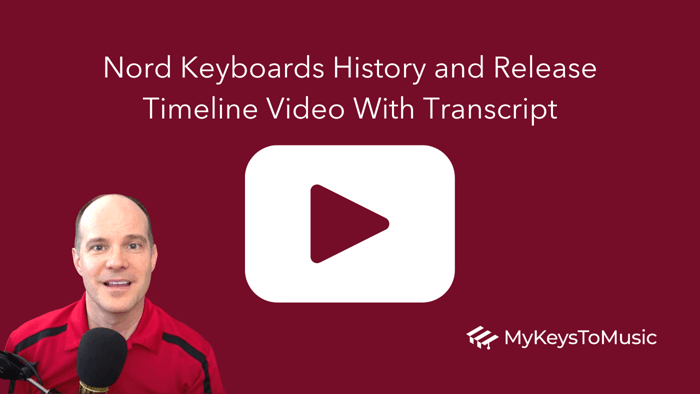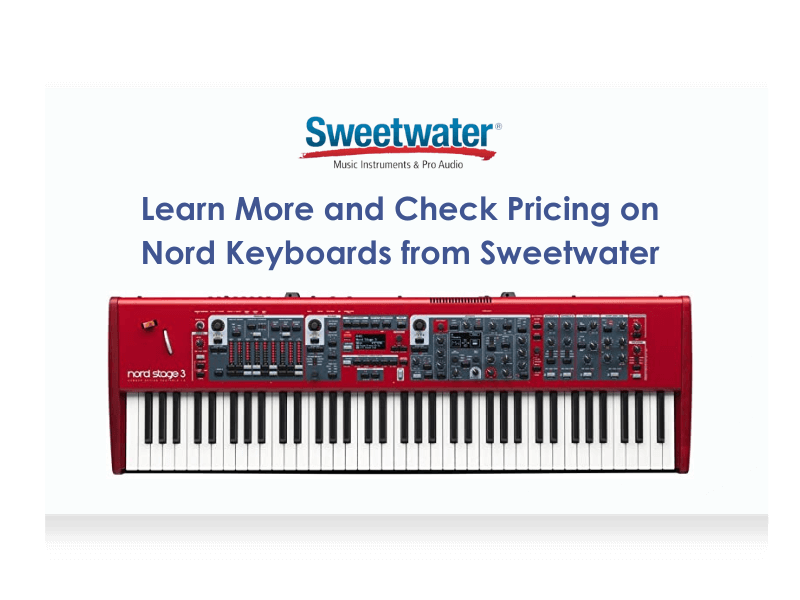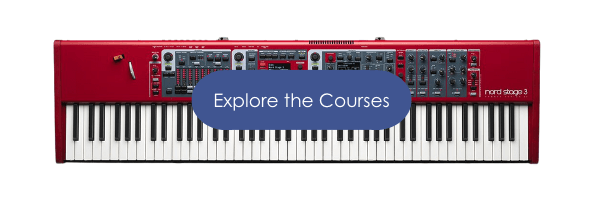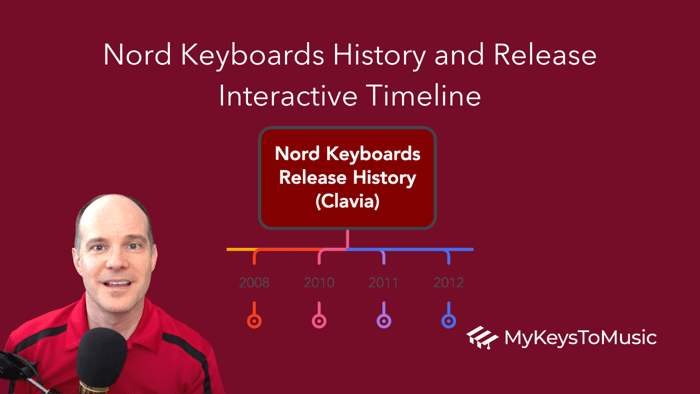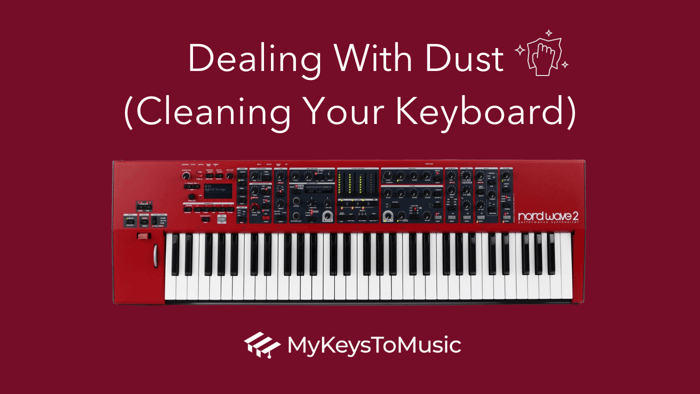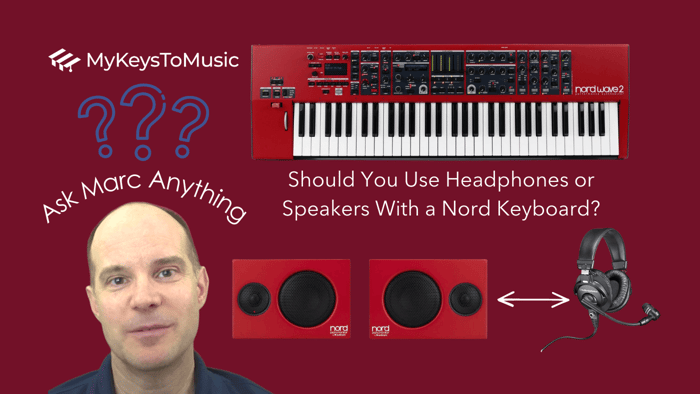Nord Keyboards History and Release Timeline
Video with Transcript
Introduction
Have you ever been interested in learning about the complete history and release of the Nord Keyboards? I have created this Nord Keyboards History and Release Timeline Video for you! In the video, I dive through the Nord product releases from 1983-2021. I have also released the full video transcript as well as linked chapters to the video if you'd prefer to read or view it that way.
Want more of the history of Nord? You can check out this blog post which includes an interactive timeline shared in two different mediums.
Video Chapters
00:00 - Intro Nord Keyboard History And Release Timeline
00:19 - 1983 Nord Percussion Plate
01:03 - 1995 (Nord Lead)
03:29 - 1997 (Nord Modular)
05:06 - 1997 (Nord Lead 2)
05:43 - 2001 (Nord Electro)
06:56 - 2001 (Nord Lead 3)
07:39 - 2002 (Nord Electro 2)
08:27 - 2003 (Nord Lead 2X)
09:27 - 2004 (Nord G2 Modular)
10:14 - 2005 (Nord Stage)
10:41 - 2005 (Nord C1 Combo Organ)
11:07 - 2005 (Nord DDRUM and company history)
11:44 - 2007 (Nord Wave)
12:16 - 2008 (Nord Stage EX)
not inc 2009 (Nord C2)
12:38 - 2003 (Nord Electro 3)
13:18 - 2008 (Nord Lead 2X Anniversary)
13:53 - 2010 (Nord Piano)
14:19 - 2011 (Nord Stage 2)
14:49 - 2011 (Nord Electro 3 HP)
15:22 - 2012 (Nord C2D Organ)
15:42 - 2012 (Nord Electro 4, Nord Piano 2, Nord Drum)
16:03 - 2013 (Nord Lead 4, Nord Drum 2, Nord Pad)
17:13 - 2014 (Nord Lead A1)
18:19 - 2015 (Nord Stage 2 EX)
18:40 - 2015 (Nord Electro 5)
18:58 - 2016 (Nord Piano 3, Nord Drum 3P)
19:36 - 2017 (Nord Stage 3)
20:07 - 2018 (Nord Piano 4)
20:52 - 2019 (Nord Grand)
21:15 - 2020 (Nord Wave 2)
21:57 - 2021 (Nord Piano 5)
22:15 - 2022 (Nord Stage 4?)
Full Transcript
Our timeline spans between 1983 and 2022. This video is recorded on April 16, 2022, and as of this recording, nothing has been officially released in 2022, although we are hoping for something as the NAMM show in June is right around the corner. Way back in 1983, the first release of any product was in fact not a keyboard. It was a digital percussion plate. According to the company's history, it all started back in 1983 when founder Hans Nordelius and noticed the first part of his last name. “Nord" created the Digital Percussion Plate
One, the first drum pad allowing for dynamic playing using sampled sounds. The DPP1 was an instant success, and soon thereafter the brand name Ddrum was introduced. The innovative drum pads featured real heads and hoops and gained huge popularity.
Many people still regard them as the best digital drum triggering system around. Then we have a huge time span between 83 and 95. I'm not exactly sure what happened during this time, I'd be curious to know.
But in 1995, the Nord Lead was introduced along with its sidekick, the Nord Rack, which is essentially the same thing without the keys. And you'll note a pattern here as we move along that most, if not all, of the leads released had an accompanying rack Mount module option. So the Nord Lead was innovative.
In 1995, Clavia released its first synthesizer, the Nord Lead. Its unique take on emulation of analog synthesis combining a distinctive sound with an intuitive user interface, made it instant classic.
Let's take a close up look at this Nord Rack module, just for a second. First of all, I noticed that the buttons and the knobs look strikingly similar to what they released today. Even this little program window looks very similar to the Nord Lead, A1 which is their latest since in the Lead series. And we've got all the basic things that you'd expect. We've got the LFO with a triangle sawtooth and random pattern for the waveform. We've got a destination with the amount and rate. We've got LFO two and Arpeggiator listed here. A modulation envelope.
Here's our waveforms for Oscillator one, semitones from negative 60 to positive 60. The basic waveforms, even noise, fine-tuning option. Then they have a configuration here where you can mix and match Oscillator one and two. We have the amp envelope with the four options, attack, decal, sustain and release. Same with the filter attack, attack, decay, sustain and release. Then we have some basic filter types. Here we have the HP 24, the LP 24, the LP 12, and the bandpass filter. The frequency cut off still labeled in red to highlight it. Resonance amount, envelope amount, optional velocity on the filter. A basic KB Track that's one setting.
Typically, nowadays we have three settings for the KBD track. Unison mode, mono, legato, and portamento. Options for modulation wheel, MIDI capability. Basic Tuning. So really today's keyboards are in many ways very similar to what we have back then. And then one could argue, well, this is what you need for basic subtractive synthesis, no matter what synth or what maker is making it.
These are the basics. This is how synthesizers work, and I do agree with that. But it is interesting to see that the heritage has been traditionalised to the point where what we see today is so similar to what we had back then. And again, this is a 30 year time frame. If you are lucky enough to still have one of these Nord Racks or the Nord Lead, please leave a comment. I'd be interested to find out and hear your story.
So two years after that, 1997, we have the release of the Nord Modular Key and its associated rack, which is the same thing without the keys. Now, the Clavia Nord Modular Series is a line of synthesizers produced by Clavia, Swedish digital synthesizer manufacturer. The Nord Modular Series,in common with their sister range, the Nord Lead series, are analog modeling synthesizers producing sounds which approximate those produced by conventional analog synths by using DSP chips to digitally model analog circuitry.
Now, what's notable about the Nord Modular, in particular, is that the Nord Modular provides an almost unlimited variation of synth architectures with the facility to simulate, in addition to subtractive synthesis, (which we think of as very traditional synthesis). We also have additive synthesis and FM synthesis, and the second generation of the series, physical modeling synthesis methods, as well as a number of other sound generation and processing techniques. So this was a unique offering back then.
They also had this Nord Micro Modular, which is another interesting thing. The Micro Modular, as we read here on Wikipedia, a little lower, was a programmable modular synthesizer with polyphonic capability, 24 bit internal processing, 96 Hz sampling frequency. Maximum of four voices depending on the patch complexity. Three assignable editing knobs, three dedicated function buttons holds 99 patches. It looks like this. Same buttons, same knobs. Notice the face panel has a sheen to it. It's more glossy than the Nord keyboards that we see today.
Okay, next. Also in that same year was the Lead 2. And yes, the Lead 2 also had an associated rack. With that, the Clavia Nord Lead 2 was launched in 1097, two years after the production of the original Nord Lead. It updated the polyphony from four to 16 voices. They also added a ring modulator. Oscillator One was syncable with the white noise generator sine waveform added for the Oscillator One increased the LFO and Arpeggiated waveforms and patterns, distortion, and four individual outputs. Patch storage was also increased. A PCMCIA storage slot was also added so that's the Nord Lead 2 and the Nord Rack 2.
Then we jump to 2001 and we see the first release of the Nord Electro.And yes, the Nord Electro had an associated rack as well. Wouldn't it be nice to have an Electro rack today with the Electro 6. There's been a lot of requests for such things. If you go to the Nord user forum, you'll read about that.
Let's go take a look at the Electro. The Nord Electro was innovative at the time. In fact, that's my first hearing of Nord keyboards was when I was lucky enough to listen to someone playing a Nord Electro, and I was just catching the end of a set, and I just couldn't believe my ears. The Nord Electro was an amazing-sounding keyboard. It imitated the Rhodes in a way that left me an impression. That said, I got to have one of those keyboards that's just amazing. I was just blown away.
In 2001, the first Nord Electro was released, introducing stunning emulations of classic vintage electromechanical instruments with a level of portability generally not associated with the original instruments. Yes, and I remember a few gigs where I was using a Rhodes electric piano, and that needed to be taken in with two individuals and set up. That's a heavy beast. Sounds great, but I'd much rather have an Electro on the gig these days, at least from a setup and tear down standpoint. Okay.
Along with the Electro came the Lead Three with its associated rack. The Nord Lead Three was a more advanced version introduced in 2001 with many new features like four operator FM synthesis, sinus modulation and an arpeggiator. The most visible new feature was replacing all the control knobs with endless Rotary knobs surrounded by a lighted indicating collar to show the current setting.
The Nord Lead 3 was, however, much more expensive than the Nord Lead 2. So the Nord Lead 2 and later, the Nord Lead 2X was sold in parallel to the flagship product. The Nord Lead 3 was in fact discontinued in 2007, leaving the Nord Lead 2X the only remaining product in the Nord Lead series.
Now, one year later, in 2002, we have the release of the Electro 2. Notice this. 2001, the first Electro, 2002 Electro 2 comes out. However, there's a little story behind that. In 2002, the Electro 2 was released. It contained new and updated software, but the electronics were identical to the original Electro, which permitted the original Electro to be updated to Electro 2 functionality through a software update. Like the original Electro, the Electro 2 was released in a 61 and 73-key version, as well as a rack version. In other words, they didn't have to recreate the wheel. They basically took the same innards, gave it some ability to update the software, and now an Electro 2 is born. That explains why it only took a year to get that out the door.
Then, one year after that, in 2003, we have the Nord Lead 2X and its associated Rack Two 2X. Clavia introduced the 2X, a refresh of the Nord Lead 2. It included increased polyphony up to 20 voices. Now high resolution 24 bit 96 khz DACs and vastly expanded patch memory. The PCMCIA patch storage was removed. The 2X retains the synthesis engine of its predecessor and consequently its sound characteristics. So a lot like what they did with the Electro. They added some more innards, which explains the 2X. They actually removed the patch storage option, and they went that direction. Now, I don't know the reason and the logic behind all of this. I would imagine that the only people who do are the people that actually worked at the factory or people with inside information, of which I am not one of those people. But it is interesting to see how companies do what they do and the decisions they make. Perhaps these are still their experimental years as to what the best offering is and what's the most feasible thing to do.
One year later, in 2004, we have the Nord G2 Modular and the Nord Modular G 2X and something called the Nord G2 Modular Engine. Now, notice I went to the Nord website for this. If you click on products on the main Nord website, which is Nordkeyboards.com, and then click Legacy, you'll be able to read a lot of the details of these offerings back then and a lot of this information, this history is preserved in its original state, which is great. Here they're explaining the modular concept where there's a marriage between the software on your computer and the synthesizer itself, and you think about today's offerings. A lot of that is commonplace where you have a marriage between the computer and the synth from a programming standpoint.
All right, one year after that, in 2005, we have the first Nord Stage. This immediately became the company flagship product. The Nord Stage surfaced in 2005, combining many of Clavia's new areas of expertise in one acoustic and electric piano sounds, organ emulations effects, and even a synthesizer stage can do it all, and I'd say it's arguably the most popular Nord keyboard today would be the Nord Stage 3 and the stage line of things. In that same year, they also released a revolutionary instrument, the Nord C1 Combo Organ. The Nord C1 Combo Organ saw the light in 2005, incorporating our second generation tone wheel modeling rotating speaker simulation, which is the Leslie Speaker, dual manuals and surprisingly lightweight at 15 kg, much smaller and easier to deal with than a B3 or any of the Hammond organs back in the day.
Also released was the Nord Ddrum. Now, an interesting thing about Ddrum is that Ddrum is an American-based Swedish company, currently a division of Armadillo Enterprises that manufactures acoustic drum sets, electronic drum sets, and electronic triggers. Ddrum was originally a brand of Clavia, makers of Nord series of keyboards and synths. In 2005, the company was sold to Armadillo Enterprises, which expanded the brand from only electronic drums into a wider range of products. So when you see the Dhum name, this was actually named by Clavia, originally taken over as its own brand, with headquarters now in Tampa, Florida.
In 2007, we have the first introduction of the Nord Wave. The Nord Wave took the Nord Lead concept to a new level in 2007, with its capability to use any audio file. Today, we refer to them as samples, as an Oscillator source in a virtual analog environment combined withthe compact, user friendly interface of a Nord product. So the concept was to take a prerecorded sound as a WAV file and then mix in with that virtual analog synthesis to come up with a whole new variety of sounds.
One year later, in 2008, we have the Nord Stage EX. Now, the Stage EX is essentially the same thing as the regular stage. It's just that the EX model has increased memory, in this case, piano memory. Here's a chart showing you the progression of memory and the different aspects and features over the years between the stage models.
In that same year, we have the Nord Electro 3, and it had been several years since we saw the Electro 2. But the Electro 3 was a completely new design, and it happens to be the very first Nord keyboard that I purchased was the Electro 3. And I bought it mainly because it had a wonderful piano engine which sounded terrific. So that pushed me over to the edge to get the Electro 3. The Electro Three is also special because that's when they exclusively licensed sounds from the Melotron and Chamberlain, and it says here the Electro 3 became one of the most successful products we've ever made. The Electro 3 was a terrific keyboard, and the only reason I sold it was to get an Electro 5. Besides the Electo 3, we have the Nord Lead 2X Anniversary Edition, which is identical to the Nord Lead Two, except this has the reverse keys.
In 2008, Clavia released a special limited edition of the Lead 2X with inverted key colors and special logos to commemorate the 25 year history of the Clavia company. Each unit of only 300 came with an individually numbered certificate. If you're lucky enough to have a Nord Lead 2X Anniversary Edition at your fingertips, please leave a comment. I'd be curious to find out your story, where you bought it, how you came to know about it.
All right, two years after that, in 2010, we have the first introduction of the Nord Piano line of things. The Nord Piano is 88 keys of pure glory, designed specially for piano players. In 2010, the streamlined Nord Piano was introduced a lightweight stage piano that featured advanced string resonance and the unique Nord triple pedal with pedal noise. So that was the birth of that
line of products in 2010, 2011.
One year later, we come to the Stage 2, which is an amazing keyboard, and you still know
a lot of people who own a Stage 2. They are just everywhere, and we let the Nord Stage
2 out of the bag at Nam 2011, supporting a new synth section with sample playback support, more memory, the C2 organ simulation and the Nord Piano pedal noise. The Nord Stage 2 raised the bar on how a stage piano should sound and behave. Lots going on with the Stage 2.
That same year, we had the Nord Electro 3 HP. So the Nord Electro HP came out several years later than the original Electro 3. And maybe that's because the hammer action portable key bed wasn't available back when the Nord Electro 3 was around. I don't know the history there. It's my understanding that these are all "Fatar" key beds with the exception of the Nord Grand. So perhaps the HP was just a new invention and they wanted to introduce that into the Electro 3. Today we have the HP key bed available on the stage, as well as the latest Electros and the pianos.
Okay, in 2012, one year after we have the Nord C2D organ. Again, a dual manual organ with lots of drawbars. A big step up from the C1, perfect for organ enthusiasts. You see a lot of these C2D organs in the latest videos from Clavia and Nord. They still bring these to the trade shows.
It's definitely still a thing.
Also released in 2012, the Electro 4. And what you'll see here is 2012 is a very busy year for Clavia. That same year, they released the Nord Piano 2 and the Nord Drum. So we've got 1, 2, 3, 4 distinctly different instrument offerings coming out the same year.
Then in 2013, we have the Nord Lead 4. Clavia announced the Nord Lead 4 at the annual Musikmesse show in Germany. That's a show very much like the NAMM show here in the States. It's almost as large, and manufacturers typically participate in both Musikmesse and NAMM. The new variant boasts an updated sound engine, new filter sections, and a true voice unison mode, which can support up to four oscillators simultaneously.
Furthermore, similar to the Nord Wave, the Lead 4 has a dedicated FX section featuring Reverb, delay, crush and distortion. The ability to quickly edit sounds whilst permitting live is made possible as a result of the new variation controls in which the user can map up to seven control parameters per program. I believe we know that today as morphing.
Also similar to the Nord Wave, the Lead 4 supports MIDI IO over USB 2.0. I wonder if this is the invention of that option for unison, which we see on the Stage 3. We see it on the Stage 2. We see it on the Lead A1. We see that also on the Wave 2.
Also in 2013, we have the accompanying Nord Lead 4R, as well as the Nord Drum 2 and the Nord Pad. We now arrive at 2014 with the release of a notable synthesizer, the Nord Lead A1. This particular model is the foundation for the construct of the modern day Nord Stage 3, which has many of the components and design features of the Lead A1 embedded within it. Along with the Nord Lead A1. We have the accompanying rack version of that as well.
At NAMM 2014, Clavia announced the Nord Lead A1. The model attempts to make the Nord Lead line accessible to a wider user-base, with a new Oscillator interface and numerous enhancements intended to facilitate quick and creative sound design. So the Lead A1 is still being manufactured and distributed today. You realize that when you go to the Nord website and then click on Products, all the products that are currently being manufactured and distributed are listed on the Products page like you see here, along with the Nord Lead A1. Anything that isn't currently being distributed or manufactured as new would be under legacy. These are the keyboards that represent the company's product history, but they're no longer being manufactured.
Then in 2015, we have the release of the Nord Stage 2 EX, which is essentially the same guts as the Stage 2, just more expanded memory. It does have a different panel, however. This has the orange against the red, which I believe makes it really easy to see the distinction within the organ engine, the Piano engine, the synth and the effects areas. And then the Electro 5. This is certainly one of my personal favorites and a keyboard that stood by my side over many years and many gigs. The Electro 5 is the first Nord keyboard with an OLED display, and you can see here from the chart it has greatly expanded memory from its previous versions.
All right, in 2016, we have the Nord Piano 3 and the Nord Drum 3P. The Nord Piano Three introduces Virtual Hammer Action Technology, which is an exclusive simulation of Hammer Action movements in the Grand Piano, delivering outstanding authenticity and dynamic response. Also featured is the Grand Weighted Action. The keyboard has added weight for improved dynamic control, providing authentic piano touch and feel. These are still fatar keyboards, but meticulously calibrated at the Nord factory to ensure an even response over the whole range. This also features a total of 1GB of memory for the piano library.
All right, in 2017. Yes, the Nord Stage 3, currently the beast. I bought this keyboard and started a YouTube channel and never looked back. This is where I've spent most of my time. Most of my videos, most of my sound creations and emulations have all been done on the Stage 3. If you're following this channel, you no doubt have already realized that and understood it. Great keyboard 2017, but look at the date it's also due for some form of upgrade. More on that later.
In 2018, we have the Nord Piano 4 introduced also at Musikmesse 2018. Some of the improvements to the previous model include 120 voice polyphony, Creative Piano filters, seamless transitions, seven split points, and optional splitpoint cross fades, a doubled 512 megabyte memory for the sample synth section, refined, organized mode, and a numeric pad for direct program access.
Also released in 2018, the famous Nord Electro 6. The Electro 6 features the ability to simultaneously play the organ, the piano, and the synth sections at the same time and mix and match between the three. It also provides seamless transitions like the Stage 3 and the Piano 4.
And perhaps this is getting close to the end of its lifecycle as well.
2019, we have the release of a very unique offering called the Nord Grand. The Nord Grand is special in a way because it's using a different key bed than any of the previous key beds used. It features an 88 note Kawhi hammer action key bed with advanced triple sensors and Ivory touch keys. It's got this nice wooden top. It's geared for those who have piano as their priority.
Then in 2020, we see the Wave 2. Now, if you look back, it had been several years between the Wave Two and the original Wave. I mean, several. I think you have to say more than several. It's an extremely powerful performance synthesizer. It is one of my favorites. I go back and forth between my favorite being the Stage 3 or the Wave 2. They fight for my attention. If I'm into sound exploration and want to do something absolutely creative, I go for the Wave 2. When I'm looking for a solid offering, I'm trying to imitate songs. I typically go for the Stage 3 because it has the piano and the organ engines, which cover a lot more songs. But the Nord Wave Two is by far a more powerful synthesizer than the Stage 3 currently offers.
Now, in 2021, we have the Nord Piano 5. And what makes the Nord Piano Five special is the fact that it has two layers where you can layer two pianos or two synths or a piano and a synth. In any combination, you're looking for 88 keys with a triple sensor action that also comes complete on the Piano 5.
So here we are in 2022, and officially, nothing is released yet, although Nam is right around the corner, like I said in June, and I'm hoping for updates either with the Electro line or the Stage Line, or both, or maybe something completely new and different.
So here's what the lineup looks like in its entirety. As you can see, there's a rich history of keyboards and instrument offerings here. Now here's another chart that was made for Nord keyboards, offered by the Nord user forum, and it features an interesting timeline which shows the beginning and end of a product's life cycle. I haven't validated the dates here, but I think it's an interesting way to present the information because they also group it by family, where each column is a different family, whether it be the leads, the modulars, the electrodes, the stages, the waves, the organs, pianos or the grand. I'll put a link to this chart below the video here so you can enjoy that because this is not the first time this topic of Nord keyboard releases has come up especially when we're all trying to predict the future to figure out what's next for Nord.
Well, hopefully you enjoyed that Clavia Nord Keyboard product release History and timeline walkthrough. Feel free to leave a comment and share your story about your first Nord keyboard. As always thanks for joining me on this video and we'll catch you on the next one!
I hope you find this tool helpful in learning more about Nord Keyboards. If you have any questions, you can leave a comment on this video.
Helpful Affiliate Links for Your Consideration (US Only):
The links above are affiliate links where I may receive a small commission from the products ordered. However, you don’t pay any extra when you use the links, but using them helps the channel and the My Keys To Music school.
Thanks for visiting!
Marc 🎹
My Keys To Music
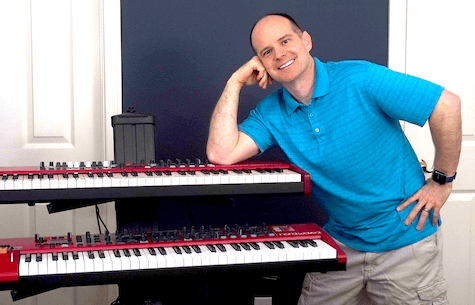
Subscribe to MyKeysToMusic Youtube Channel
